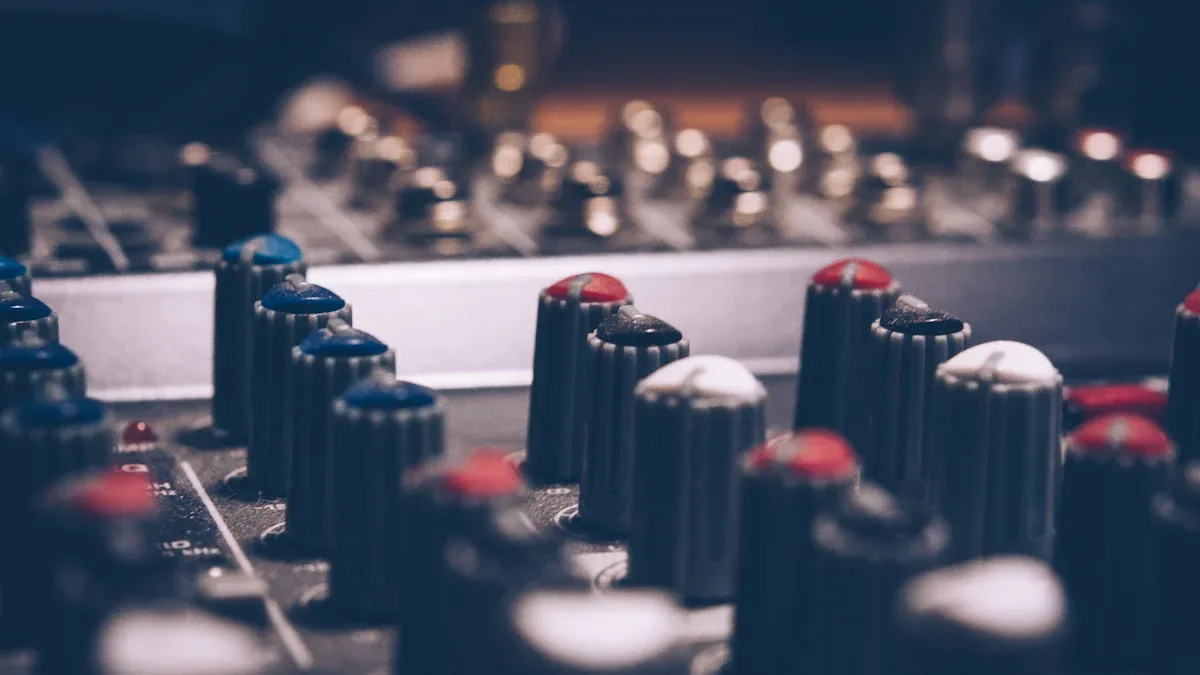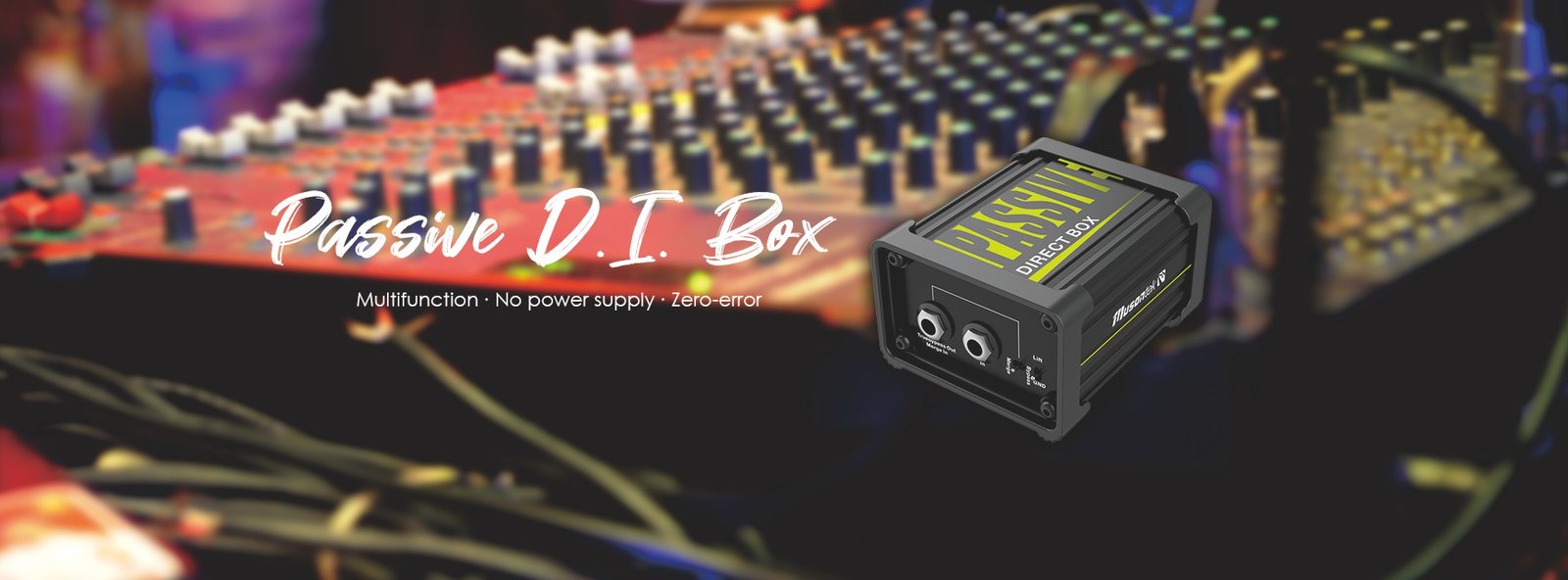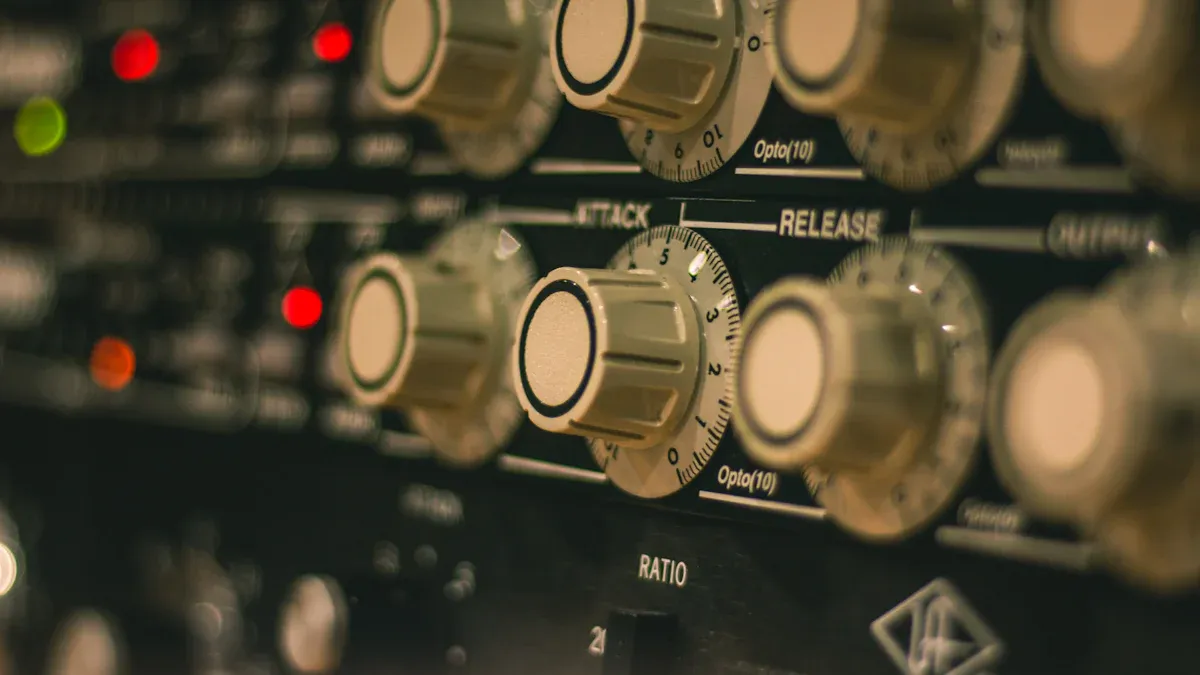
With a Passive DI Box, you never have to worry about power requirements. The Musontek Passive DI box- PD1L is ready to use straight out of the box, utilizing a transformer to convert your instrument’s signal efficiently. Just plug in and play—no batteries or phantom power needed. Unlike an active DI Box, which requires a power source such as a battery or phantom power to boost weak signals, the Passive DI box- PD1L offers a straightforward and dependable solution for connecting your gear. Whether you choose the Passive DI box- PD1L or the Passive DI box- PD1X, Musontek’s passive DI Box options deliver reliable performance every time.
Key Takeaways
Passive DI boxes, such as the Musontek PD1L, do not need power. You only have to plug in your instrument and start playing.
Transformers inside passive DI boxes change high-impedance signals to low-impedance signals. This helps keep the sound clear.
These boxes work well for live shows. They are dependable and you do not need batteries or phantom power.
The ground lift switch helps stop hum and noise. This keeps your audio sounding good.
Pick a passive DI box for strong signals from instruments like electric keyboards. You will get the best sound this way.
Passive di box power basics

How passive di box works
You might wonder how a passive di box like the Musontek PD1L works without power. The secret is its transformer. When you plug in your instrument, the signal goes through an isolation transformer. This transformer changes the signal from high-impedance and unbalanced to low-impedance and balanced. You get a clean and strong signal for mixers or recording gear.
Here’s a simple table that shows what the transformer does inside a passive di box:
Component | Function | Impact on Signal |
|---|---|---|
Isolation Transformer | Electromagnetic signal transfer | Keeps the signal safe and breaks the ground connection |
Passive di boxes only use passive parts. These parts do not make your signal louder, so they do not need power. You just plug in and play. The transformer also helps protect your signal from noise and hum. You get good sound every time.
No power needed for operation
You never have to worry about batteries or phantom power with a passive di box. Here’s why:
Passive di boxes use passive parts.
These parts do not make signals louder, so they do not need power.
Transformers inside the box change high-impedance signals to low-impedance signals.
This design makes passive di boxes very easy to use. You can use them anywhere and anytime. You do not need to look for power outlets or bring extra batteries. You just connect your instrument and start playing.
Passive di boxes have some big benefits over active ones. You get easy use and great electrical isolation between input and output. You do not need a power supply, so you can use your passive di box in many places. The transformer keeps your instrument separate from other gear, which helps stop ground loops and keeps your sound clean.
Passive di boxes like the Musontek PD1L are great for live shows. They are strong and dependable, so you can trust them on stage or on tour. You do not have to worry about power problems. They keep working even if the environment changes.
Let’s see how temperature and humidity affect passive di boxes:
Environmental Factor | Effect on Passive DI Boxes |
|---|---|
Temperature | Small changes after humidity shifts; boxes adjust fast to new surroundings |
Humidity | Buffered effect; filled boxes show lower RH because of moisture absorption or release |
You also get extra safety with passive di boxes. Since they do not need a power supply, you lower the risk of electrical problems. Just make sure you connect everything the right way. The GND/LIFT switch helps remove hum and keeps your audio quality high, especially during big shows.
Passive di boxes give you a simple, safe, and reliable way to connect your instruments. You do not need to think about power. You just focus on your music.
Passive direct box features
Musontek PD1L key features
You want gear that makes your life easier. The Musontek PD1L passive direct box packs a lot of helpful features into a small box. Here’s a quick look at what you get:
Feature | Description |
|---|---|
Passive Discrete Circuitry | No batteries or power needed; keeps your signal clean. |
Plug-and-Play Operation | Just connect and play—no setup headaches. |
Preserves the Real Sound | Keeps your instrument’s true tone and dynamics. |
Handles Huge Transient Signals | Deals with loud spikes without distortion. |
Ground Lift Switch | Removes hum and buzz from ground loops. |
Pad Switch | Lowers strong signals so you avoid distortion. |
Merge Mode | Works with both instrument and line-level signals. |
Phase Reverse Switch | Fixes phase problems for balanced sound. |
You get a passive direct box that’s ready for any situation. The pad switch and phase reverse help you control your sound, especially when you play live. If your instrument is loud, the pad switch keeps things smooth. The phase reverse switch solves tricky phase issues fast.
Signal quality and tone preservation
You care about your sound. The Musontek PD1L makes sure your signal stays pure. The passive direct box uses high-quality parts, so you don’t get extra noise or distortion. You hear your instrument’s real voice, not a colored or muddy version.
Good transformers inside the box keep your audio clear.
Pads help you manage strong signals, so your sound stays clean.
The box works well with active sources and keeps your tone true.
If you play in the studio, you want every detail to come through. The PD1L helps you capture all the dynamics and character of your instrument. You don’t lose the magic in your music.
Ground lift and noise control
Noise can ruin a show or a recording. The ground lift switch on the Musontek PD1L helps you fight hum and buzz. You flip the switch, and ground loop problems disappear. Many sound engineers say this feature saves the day at gigs.
Tip: If you hear a hum, try the ground lift switch first. It often solves the problem instantly.
You get a clean signal, even in tough environments. The passive direct box keeps your setup simple and reliable. You focus on your music, not on fixing noise issues.
Passive vs active di box

Power requirements compared
You might wonder what makes a passive di box different from an active direct box when it comes to power. The answer is simple. You never need batteries or phantom power for a passive di box. It uses a transformer to do its job. You just plug in your instrument and play. An active direct box needs power. You have to use batteries or phantom power from your mixer. This extra step can slow you down if you forget your batteries or if phantom power is not available.
Here’s a quick look at how much you might spend on each type:
Type | Price Range |
|---|---|
Passive DI | $23 – $99 |
Active DI | $199 – $700 |
Passive di boxes save you money and time. You do not need to worry about power or extra gear. You get a simple setup that works every time.
Use cases and instrument types
You want the right tool for your instrument. Some instruments work better with passive di boxes, while others need active DIs. Here’s a table to help you choose:
Instrument Type | Paired with DI Box Type |
|---|---|
Active instruments (e.g., electric keyboards) | Passive DI boxes |
Passive instruments (e.g., vintage pickups, acoustic instruments) | Active DI boxes |
If you play an electric keyboard or a drum machine, you should grab a passive di box. These instruments have strong signals. The transformer inside the passive box handles them easily. If you use a guitar with old pickups or an acoustic instrument, you need an active DI. It boosts weak signals and keeps your sound clear.
Tip: Always match your instrument’s output with the right DI box. You get better sound and fewer problems.
Performance differences
You care about how your music sounds. Both passive and active DIs have their own strengths. Let’s break it down:
Active DI boxes give you higher output and lower noise. They work best with quiet instruments.
Passive di boxes handle overload better. If your signal gets too strong, the transformer inside creates a soft, vintage distortion. Many musicians love this sound.
The quality of the transformer in a passive di box matters. Good transformers keep your signal clean and reduce noise. Cheap active DIs can add unwanted hiss or buzz.
Passive direct boxes use transformers to match impedance and balance your signal. This design helps remove noise from ground loops. You get a natural compression when the transformer saturates. Your music sounds warm and smooth, not harsh or clipped.
So, when should you choose a passive di box? If you play live shows with active instruments, you want something simple and reliable. Passive DIs like the Musontek PD1L give you plug-and-play ease and great sound. If you record with quiet, passive instruments, an active direct box gives you the boost you need.
You get the best results when you pick the right DI for your setup. Your music will sound clear, strong, and free from unwanted noise.
Choosing the right di box
Practical tips for selection
Picking the right di box can feel tricky, but you can make it simple by thinking about a few key things. You want your music to sound great, so start with your instrument. Is it active or passive? That matters. Next, check if your setup needs to match impedance. Some instruments work better with certain di boxes. You should also decide if you want a passive or active di. Each type gives you a different sound. Look for features like high-quality transformers and a wide dynamic range. These help keep your signal clean and strong. If you play live, remember that active di boxes need power. You might not want to worry about batteries or phantom power during a show.
Tip: Always test your gear before a gig. You can catch problems early and avoid surprises.
When to use passive di box
You might wonder when a passive di box is the best choice. If you play electric keyboards, synths, or battery-powered guitars, you should grab a passive box. These instruments have strong signals, so they do not need extra boost. Passive di boxes use transformers to convert signals without needing power. You get a smooth, warm tone that many musicians love. This makes passive di boxes perfect for live shows and studio work where you want reliability and great sound.
Let’s see how the Musontek PD1L stacks up against other passive di boxes:
Feature | MUSONTEK PD1L | Other Passive DI Boxes |
|---|---|---|
High-Cut Shifter | Yes | Varies |
Selectable Pad Options | -15dB / -25dB | Varies |
Phase Reverse | Yes | Varies |
Handles Transient Signals | Yes, without distortion | Varies |
Phantom Power Requirement | None | Varies |
Reliability in Noisy Settings | High | Varies |
You can trust the Musontek PD1L in many situations. It works well with different instruments and setups. You do not need to worry about power or noise. The PD1L gives you flexibility and strong performance every time.
You want gear that keeps things simple and sounds great. A passive di box like the Musontek PD1L does not need power, so you never worry about batteries or cables. Check out these benefits:
Benefit | What It Means for You |
|---|---|
Natural sound | Your instrument stays true |
Handles loud signals | No distortion, even when you play hard |
No power needed | Plug in and play anywhere |
Low noise | Clean sound every time |
Think about your setup and what matters most. If you want easy use and pure tone, a passive di box is a smart pick.
FAQ
Do you need batteries or phantom power for the Musontek PD1L?
Nope! You never need batteries or phantom power. The Musontek PD1L works with a transformer. Just plug in your instrument and start playing. You get instant setup every time.
Can you use the Musontek PD1L with any instrument?
You can use it with most active instruments like keyboards, drum machines, and electric guitars with built-in preamps. If your instrument has a strong signal, the PD1L handles it easily.
What does the ground lift switch do?
The ground lift switch helps you remove hum and buzz from your audio signal. Flip the switch if you hear unwanted noise. You get a cleaner sound right away.
Is the Musontek PD1L good for live shows and studio recording?
Absolutely! You get reliable performance on stage and in the studio. The PD1L keeps your sound clear and true. Musicians and sound engineers trust it for both live gigs and recording sessions.
How do you fix distortion from loud signals?
Just use the pad switch on the PD1L. It lowers strong signals so you avoid distortion. You keep your tone smooth, even when you play hard.